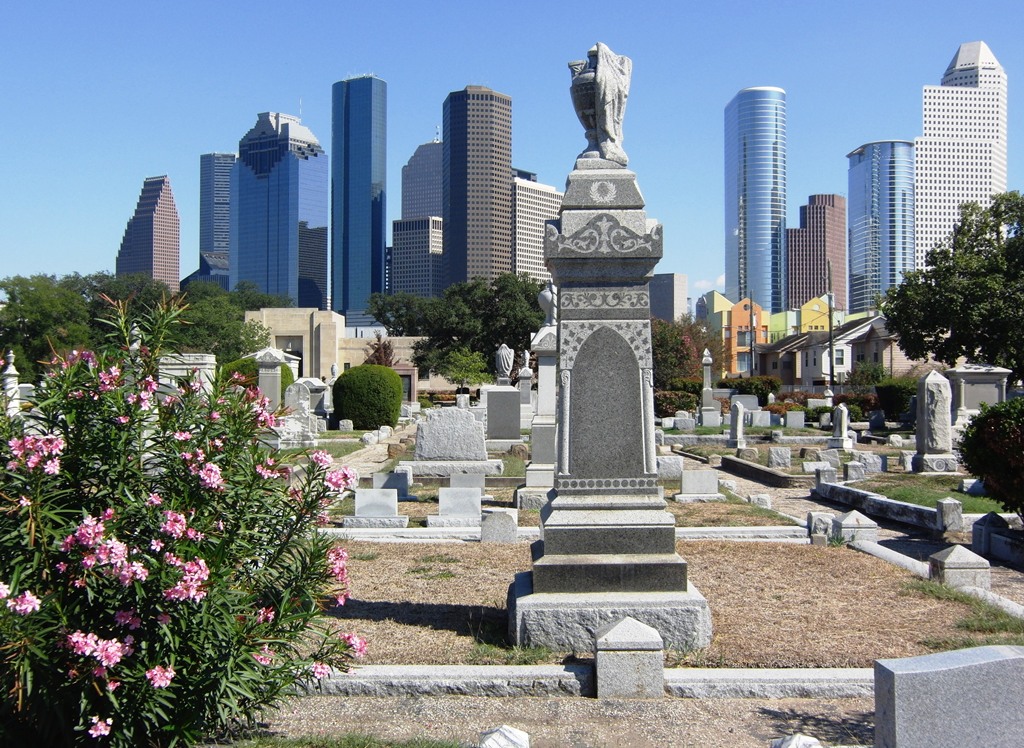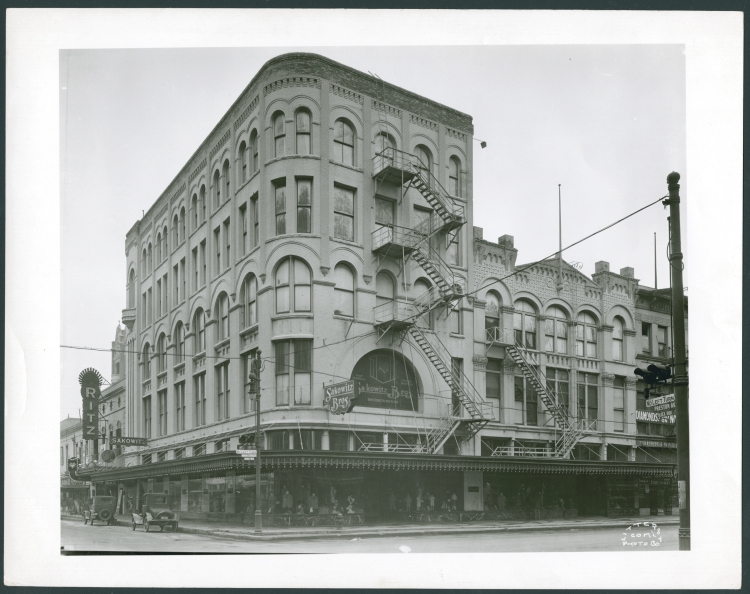Beth Israel Cemetery
1207 West Dallas
Established 1844
4 Acres
Burials: Unknown
Texas Historical Marker
beth-israel
“The lamp of the Eternal One is the human soul.”
– Proverbs 20:27
Cemeteries always came first where Jews gathered and Houston was no exception. Beth Israel, Texas’ oldest Jewish graveyard, was dedicated 10 years prior to the opening of the first synagogue in the city. Early burials here reflect the large Jewish immigration from Europe to Houston. Tombstones list places of birth as Bohemia, Bavaria, Prussia, Alsace, Poland and Holland. Many of the epitaphs are in German and Hebrew.
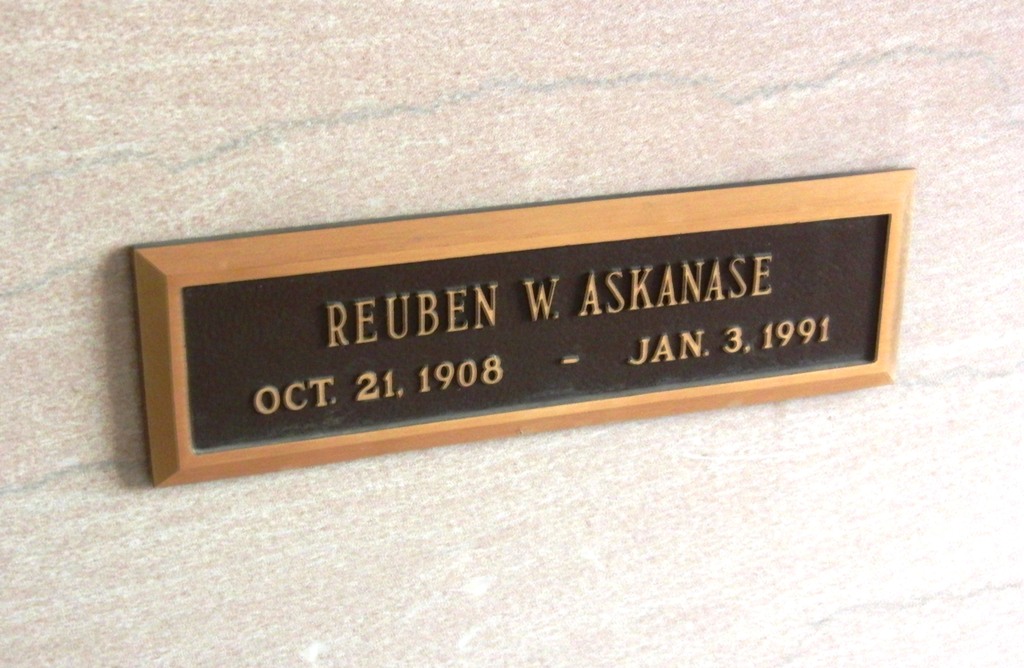 Askanase, Reuben W. (1908-1991) – Businessman – This is a rags to riches story for which Houston is so well known. Askanase was born in North Dakota. As a boy he helped the family by selling newspapers and serving meals from his mother’s chuck wagon to working men in the West. After putting himself through North Dakota State University he moved to Brooklyn. He joined Abraham & Strauss, a department store, as an office boy whose job included sharpening pencils. Later Askanase was promoted to vice president. He came to Houston in 1945 where he eventually built Dunhill International. A civic minded gentleman he was active in the Houston Sports Association, Houston Symphony, Alley Theater and Rothko Chapel to mention a few of his passions.
Askanase, Reuben W. (1908-1991) – Businessman – This is a rags to riches story for which Houston is so well known. Askanase was born in North Dakota. As a boy he helped the family by selling newspapers and serving meals from his mother’s chuck wagon to working men in the West. After putting himself through North Dakota State University he moved to Brooklyn. He joined Abraham & Strauss, a department store, as an office boy whose job included sharpening pencils. Later Askanase was promoted to vice president. He came to Houston in 1945 where he eventually built Dunhill International. A civic minded gentleman he was active in the Houston Sports Association, Houston Symphony, Alley Theater and Rothko Chapel to mention a few of his passions.
 Barnston, Henry (1868-1949) – Rabbi – He was born in Dover, England. Barnston was educated there as well as in Germany. He received his rabbinical diploma in London and his Doctorate of Philosophy at the University of Heidelberg in Germany. Barnston received additional degrees from Jews’ College and the University College of London. Before moving to America he worked at the British Museum in the field of Semitics. He immigrated to the U. S. because he knew his liberal Reform views were incompatible with the prevailing practice of Judaism in England. Barnston arrived in Houston in 1900 after answering an advertisement from Temple Beth Israel seeking a Reform rabbi. During his tenure he oversaw the construction of two synagogues (in 1908 at Lamar and Crawford and in 1925 at Austin at Holman) and the mausoleum in the Beth Israel cemetery on W. Dallas in 1936. Barnston retired in 1943 but remained a driving force at the synagogue until his death six years later. Upon hearing of his death Jessie H. Jones said “the recent passing of Dr. Henry Barnston leaves a decided void in the religious, cultural and civic life of Houston.”
Barnston, Henry (1868-1949) – Rabbi – He was born in Dover, England. Barnston was educated there as well as in Germany. He received his rabbinical diploma in London and his Doctorate of Philosophy at the University of Heidelberg in Germany. Barnston received additional degrees from Jews’ College and the University College of London. Before moving to America he worked at the British Museum in the field of Semitics. He immigrated to the U. S. because he knew his liberal Reform views were incompatible with the prevailing practice of Judaism in England. Barnston arrived in Houston in 1900 after answering an advertisement from Temple Beth Israel seeking a Reform rabbi. During his tenure he oversaw the construction of two synagogues (in 1908 at Lamar and Crawford and in 1925 at Austin at Holman) and the mausoleum in the Beth Israel cemetery on W. Dallas in 1936. Barnston retired in 1943 but remained a driving force at the synagogue until his death six years later. Upon hearing of his death Jessie H. Jones said “the recent passing of Dr. Henry Barnston leaves a decided void in the religious, cultural and civic life of Houston.”
 Battelstein, Harry I. (1903-1987) – Retailer – He is a descendant of Phillip Battelstein, a Lithuanian who arrived in Houston with $4 in his pocket and founded Battelstein’s Tailor Shop in 1897. When that shop burned down he relocated to 812 Main and opened Battelstein’s Department Store. Following school Harry joined the family business where he worked until the chain was sold in 1980.
Battelstein, Harry I. (1903-1987) – Retailer – He is a descendant of Phillip Battelstein, a Lithuanian who arrived in Houston with $4 in his pocket and founded Battelstein’s Tailor Shop in 1897. When that shop burned down he relocated to 812 Main and opened Battelstein’s Department Store. Following school Harry joined the family business where he worked until the chain was sold in 1980.

Houston City Hall, 1939
Finger, Joseph (1887-1953) – Architect – He was the preeminent Jewish architect in Houston during the first half of the 20th century. Born in Austria, his family immigrated to Buffalo, New York when he was 18 years old. He arrived in Houston in 1912, becoming a junior partner in the architectural firm of Green and Finger (later Finger and Rustay). During his distinguished career Finger designed City Hall (1939); numerous hotels including the Auditorium (1926), Texas State (1924) and Plaza (1926); Jefferson Davis Hospital (1937); Clarke & Courts Building (1936); Temple Beth Israel (1925); Houston Municipal Airport Terminal (1940) and Houston Coliseum and Music Hall (1937) to mention the most notable edifices. Finger died in 1953 and is interred in the Temple of Rest mausoleum (which he designed in 1935).
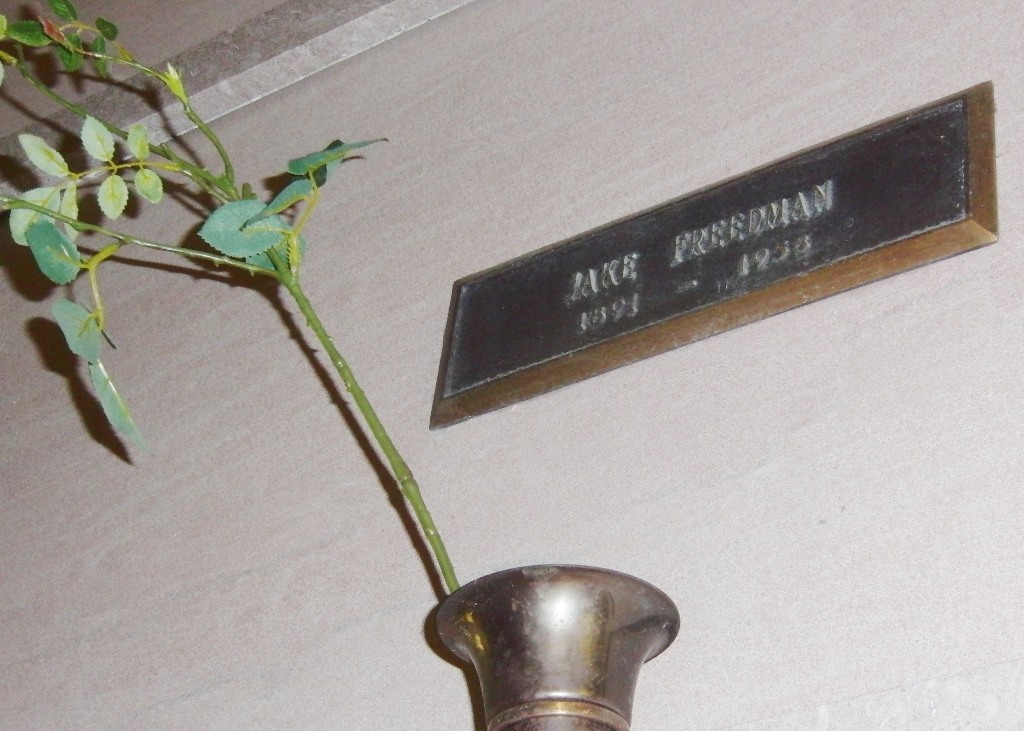 Freedman, Jake “Jackie” (1891-1958) – Professional Gambler and Casino Owner – He was one of Houston’s most interesting and colorful characters in the first half of the 20th century. Freedman was born in Odessa, Russia and immigrated to America prior to WW I. He gained U. S. citizenship by joining the Army and fighting in that conflict. His gambling career began in Galveston where he partnered with mobsters Dutch Voight, Ollie Quinn and Sam and Rose Maceo. Freedman owned a piece of the upscale Hollywood Dinner Club, a renowned gambling hall. Soon he went out on his own opening gambling joints in the unincorporated areas between Galveston and Houston. His palatial home on South Main in Houston, Domain Privee, was also a gambling mecca. When Texas authorities cracked down on gambling he moved to Las Vegas in 1952 where he and his partners opened the Sands Hotel & Casino. While in Vegas he is credited with inventing the eye in the sky camera that allows casino employees to watch for cheating. Freedman died in Los Angeles during heart surgery in 1958.
Freedman, Jake “Jackie” (1891-1958) – Professional Gambler and Casino Owner – He was one of Houston’s most interesting and colorful characters in the first half of the 20th century. Freedman was born in Odessa, Russia and immigrated to America prior to WW I. He gained U. S. citizenship by joining the Army and fighting in that conflict. His gambling career began in Galveston where he partnered with mobsters Dutch Voight, Ollie Quinn and Sam and Rose Maceo. Freedman owned a piece of the upscale Hollywood Dinner Club, a renowned gambling hall. Soon he went out on his own opening gambling joints in the unincorporated areas between Galveston and Houston. His palatial home on South Main in Houston, Domain Privee, was also a gambling mecca. When Texas authorities cracked down on gambling he moved to Las Vegas in 1952 where he and his partners opened the Sands Hotel & Casino. While in Vegas he is credited with inventing the eye in the sky camera that allows casino employees to watch for cheating. Freedman died in Los Angeles during heart surgery in 1958.
 Gordon, Meyer Morris (1882-1961) – Businessman – Born in Lithuania, Gordon immigrated to Texas in the late 1890s. His family moved to Galveston in 1897. Gordon survived the Great Galveston Storm of 1900 but moved to Houston shortly thereafter. With $400 in capital he opened a general store. In 1916 Gordon established a jewelry store at 808 Preston Avenue. Over the years that business would grow into the second largest retail jewelry chain in the world with 636 stores in 1982. Gordon’s Jewelers was bought by its main competitor, Zale Corporation, in 1989. It is still considered one of the country’s premier regional jewelers today.
Gordon, Meyer Morris (1882-1961) – Businessman – Born in Lithuania, Gordon immigrated to Texas in the late 1890s. His family moved to Galveston in 1897. Gordon survived the Great Galveston Storm of 1900 but moved to Houston shortly thereafter. With $400 in capital he opened a general store. In 1916 Gordon established a jewelry store at 808 Preston Avenue. Over the years that business would grow into the second largest retail jewelry chain in the world with 636 stores in 1982. Gordon’s Jewelers was bought by its main competitor, Zale Corporation, in 1989. It is still considered one of the country’s premier regional jewelers today.
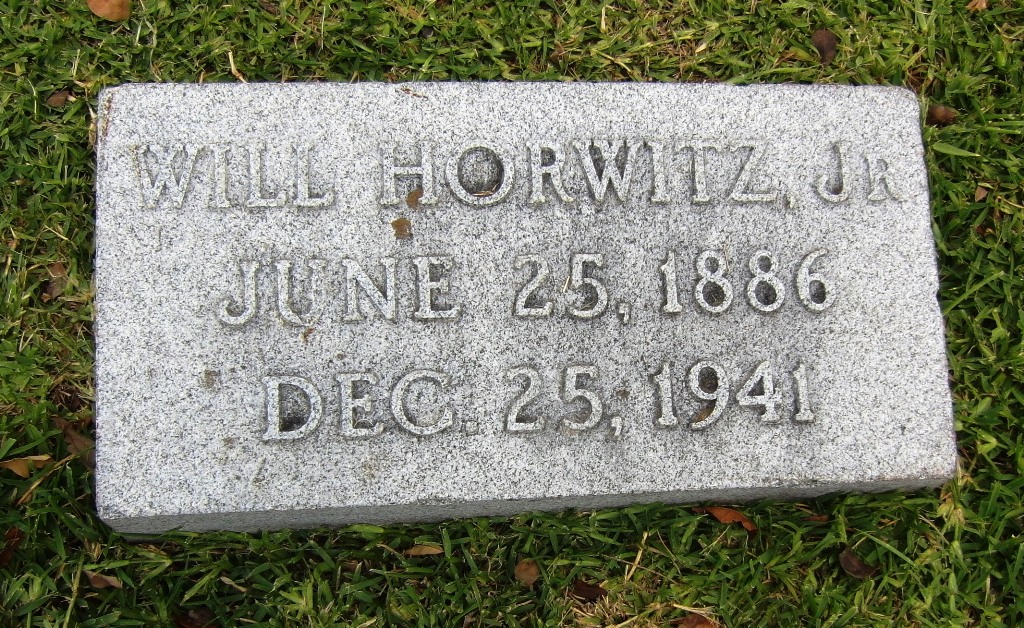 Horwitz Jr, Will (1886-1941) – Businessman – Horwitz, philanthropist, theater operator, showman and flower fancier, was born in Benton, Arkansas. He came to Houston in 1917 and opened a theater at Camp Logan, showing motion pictures to the troops stationed there. Two years later he established the first theater of the Horwitz chain in downtown, naming it the Iris after his daughter. Horwitz added three more picture houses – Uptown, Texas and Ritz. In 1925 the Texas became the first air conditioned theater in the state. Always the showman, Horwitz licensed Houston’s first radio station, WEAY. During the Great Depression he fed more than 100,000 people free meals. One day a week during those lean years was “tin can day” at his theaters. Anyone could see a movie in exchange for a tin can of food which he distributed to the needy through a store he owned at Capitol and Travis. His 46-acre estate in Dickinson was a horticultural paradise of exotic flowers. Rabbi Henry Barnston (See Barnston) presided at Horwitz funeral.
Horwitz Jr, Will (1886-1941) – Businessman – Horwitz, philanthropist, theater operator, showman and flower fancier, was born in Benton, Arkansas. He came to Houston in 1917 and opened a theater at Camp Logan, showing motion pictures to the troops stationed there. Two years later he established the first theater of the Horwitz chain in downtown, naming it the Iris after his daughter. Horwitz added three more picture houses – Uptown, Texas and Ritz. In 1925 the Texas became the first air conditioned theater in the state. Always the showman, Horwitz licensed Houston’s first radio station, WEAY. During the Great Depression he fed more than 100,000 people free meals. One day a week during those lean years was “tin can day” at his theaters. Anyone could see a movie in exchange for a tin can of food which he distributed to the needy through a store he owned at Capitol and Travis. His 46-acre estate in Dickinson was a horticultural paradise of exotic flowers. Rabbi Henry Barnston (See Barnston) presided at Horwitz funeral.
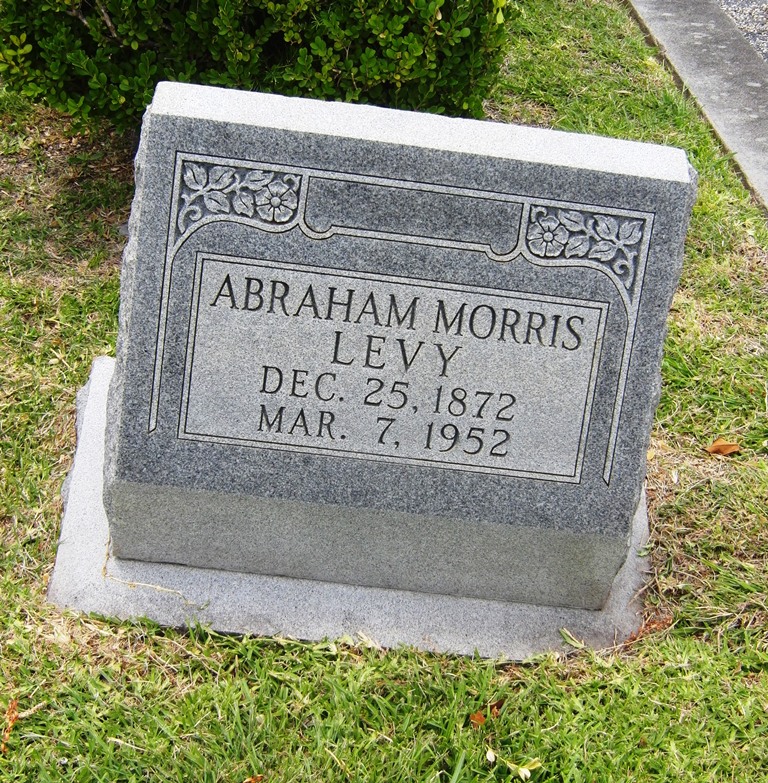 Levy, Abraham M. (1859-1924) – Businessman – A native Houstonian, Levy entered the retail trade as a store clerk. In 1887 he joined with his brother Leo to found Levy Brothers Dry Goods Company. The business grew rapidly and at one time was the largest mercantile operation in the southern United States. In addition to his business activities Levy was involved with the American Red Cross and United Jewish Charities. At the time of his death he made it “… possible for the Beth Israel Congregation to proceed with its plan to erect a Noble Temple to the Glory of God” and provided “…the munificent gift of the completion of the Community House…” In 1925 that synagogue, designed by Joseph Finger (See Finger), was erected at Austin and Holman and served the Congregation until they moved to 5600 N. Braeswood in 1967.
Levy, Abraham M. (1859-1924) – Businessman – A native Houstonian, Levy entered the retail trade as a store clerk. In 1887 he joined with his brother Leo to found Levy Brothers Dry Goods Company. The business grew rapidly and at one time was the largest mercantile operation in the southern United States. In addition to his business activities Levy was involved with the American Red Cross and United Jewish Charities. At the time of his death he made it “… possible for the Beth Israel Congregation to proceed with its plan to erect a Noble Temple to the Glory of God” and provided “…the munificent gift of the completion of the Community House…” In 1925 that synagogue, designed by Joseph Finger (See Finger), was erected at Austin and Holman and served the Congregation until they moved to 5600 N. Braeswood in 1967.
 Levy, Louis A. (1799-1861) – Occupation Unknown – We know nothing about this person except that he lived in Texas when it was a republic. Recently, the Daughters of the Republic of Texas began placing a bronze medallion on the graves of these individuals. To earn a Citizen of the Republic of Texas marker the person must have lived here between 1836 and 1845, the year Texas joined the Union.
Levy, Louis A. (1799-1861) – Occupation Unknown – We know nothing about this person except that he lived in Texas when it was a republic. Recently, the Daughters of the Republic of Texas began placing a bronze medallion on the graves of these individuals. To earn a Citizen of the Republic of Texas marker the person must have lived here between 1836 and 1845, the year Texas joined the Union.
 Meyer, Leopold Leopold (1892-1982) – Businessman – This Galveston native has Leopold in his name twice as he was named for his grandfather and godfather who both had that first name. He joined his brothers in the retail business in his home town but moved to Houston in 1918 to join Foley Brothers Dry Goods Company. The hard working Meyer became executive vice president and credit manager. In 1946 he left to join his family in the founding of Meyer Brothers. A great philanthropist, he raised huge sums of money for Texas Children’s Hospital following the tragic death of his 15 year old daughter in 1939. He was also instrumental in St. Luke’s Episcopal Hospital, Community Chest, Baylor College of Medicine, Pin Oak Charity Horse Show and Houston Livestock Show & Rodeo.
Meyer, Leopold Leopold (1892-1982) – Businessman – This Galveston native has Leopold in his name twice as he was named for his grandfather and godfather who both had that first name. He joined his brothers in the retail business in his home town but moved to Houston in 1918 to join Foley Brothers Dry Goods Company. The hard working Meyer became executive vice president and credit manager. In 1946 he left to join his family in the founding of Meyer Brothers. A great philanthropist, he raised huge sums of money for Texas Children’s Hospital following the tragic death of his 15 year old daughter in 1939. He was also instrumental in St. Luke’s Episcopal Hospital, Community Chest, Baylor College of Medicine, Pin Oak Charity Horse Show and Houston Livestock Show & Rodeo.
 Pye, H. Walter (1905-1977) – Clothier – In 1936 this gentleman opened Walter Pye’s Men’s Shop in Houston. It was one of the earliest Houston retailers to focus on clothing for men. At its peak, Pye’s operated six upscale clothing stores, but the last one closed in 1994. However, his son opened Walter Pye’s NAL (National Apparel Liquidators) Superstores. The latter was purchased by Men’s Warehouse in 1997.
Pye, H. Walter (1905-1977) – Clothier – In 1936 this gentleman opened Walter Pye’s Men’s Shop in Houston. It was one of the earliest Houston retailers to focus on clothing for men. At its peak, Pye’s operated six upscale clothing stores, but the last one closed in 1994. However, his son opened Walter Pye’s NAL (National Apparel Liquidators) Superstores. The latter was purchased by Men’s Warehouse in 1997.
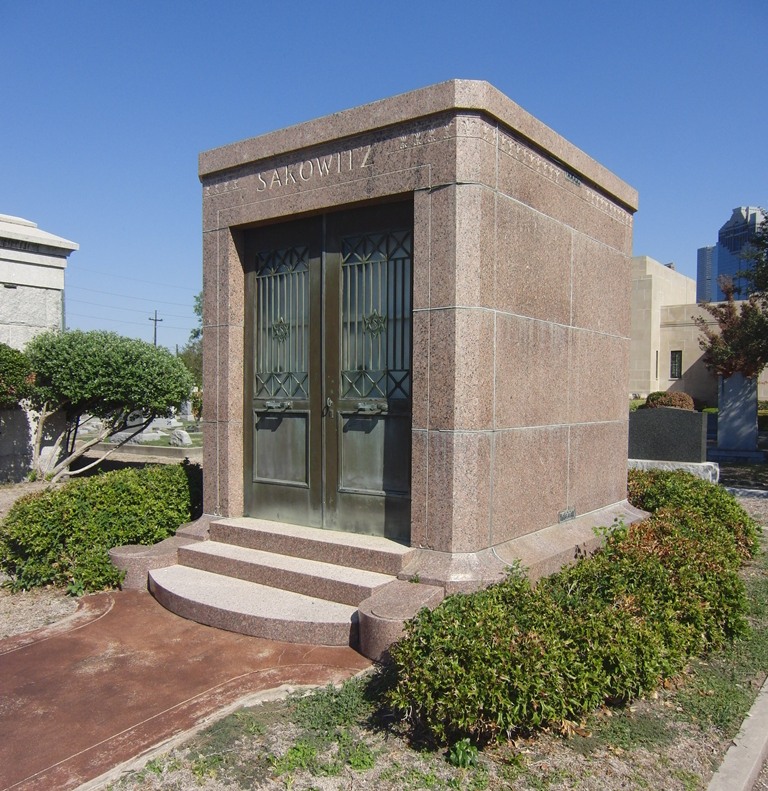 Sakowitz, Tobias (1882-1970) – Businessman – Born in the Ukraine he remained there studying to be a rabbi after his family immigrated to America. However, Sakowitz joined them in Galveston in 1897 and worked in the family retail business. Miraculously, they survived the Great Storm of 1900. He and his brother Simon (See Sakowitz, Simon) opened the first Sakowitz Brothers, a department store, in 1902 on the island. They were less fortunate when their business was nearly destroyed by the 1915 Hurricane. In 1917 the brothers moved to Houston and opened a Sakowitz Brothers store on Main Street. The company eventually became the premier clothier in the city. Sakowitz served as a board member of the United Fund and the Houston Chamber of Commerce.
Sakowitz, Tobias (1882-1970) – Businessman – Born in the Ukraine he remained there studying to be a rabbi after his family immigrated to America. However, Sakowitz joined them in Galveston in 1897 and worked in the family retail business. Miraculously, they survived the Great Storm of 1900. He and his brother Simon (See Sakowitz, Simon) opened the first Sakowitz Brothers, a department store, in 1902 on the island. They were less fortunate when their business was nearly destroyed by the 1915 Hurricane. In 1917 the brothers moved to Houston and opened a Sakowitz Brothers store on Main Street. The company eventually became the premier clothier in the city. Sakowitz served as a board member of the United Fund and the Houston Chamber of Commerce.
Sakowitz, Simon (1883-1967) – Businessman – He was the younger brother of Tobias (See Sakowitz, Tobias). Simon arrived in Galveston with his mother and two siblings in the late-1880s. He opened Sakowitz Brothers in 1902 with Tobias then moved to Houston to start a location in 1915. Following the devastating storm of 1915 that hit Galveston the brothers consolidated the business in Houston. Initially a men’s and boy’s apparel store, women’s clothing was added in 1929 when the store moved into larger space in the Gulf Building on Main at Rusk. The civic minded Simon was active in the Houston Symphony, Baylor College of Medicine and the University of Houston.
Sakowitz, Bernard (1907-1981) – Businessman – Bernard, son of Tobias (See Sakowitz, Tobias), was born on Galveston Island. Following college he began his retailing career at R. H. Macy Company in New York City. Returning to Houston in 1929 he joined Sakowitz Brothers and was named president of the company in 1957. The company flourished under his steerage. In addition to the Main Street store he located branches in Gulfgate Mall, the Shamrock Hotel (no longer existing) and the Galleria area. Not finished yet he took the brand to Dallas, Midland and Phoenix. Like other members of the Sakowitz clan he was involved in many civic activities including Texas Medical Center, Houston Crime Commission, Kiwanis Club and Houston Chamber of Commerce.
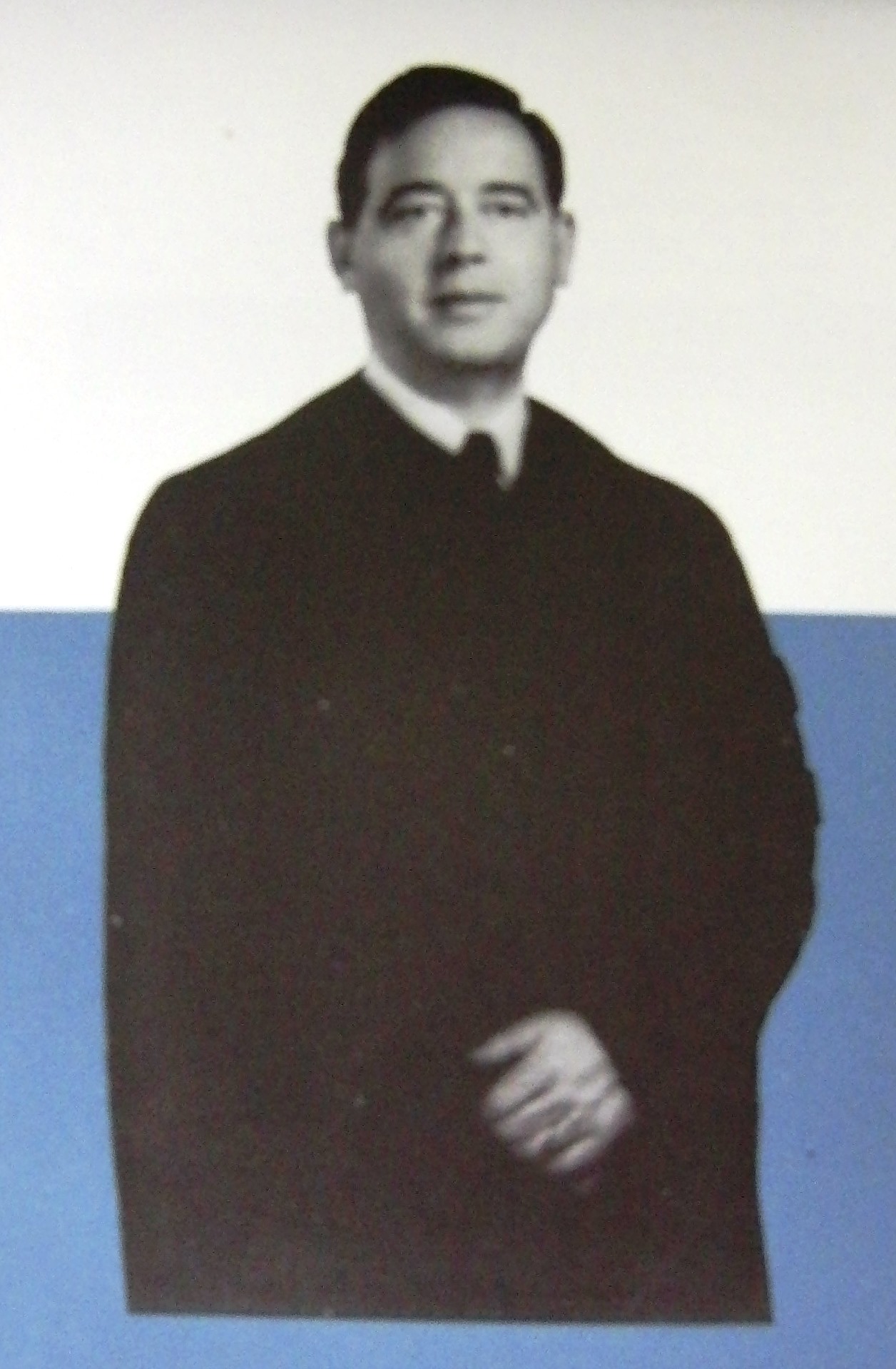 Schachtel, Hyman Judah (1907-1990) – Rabbi – Born in London, England, his family immigrated to America in 1914. They sailed on the ill-fated RMS Lusitania less than a year before U-20, a German submarine, torpedoed her with the loss of 1,198 innocent lives. Raised in Brooklyn he was attracted to the Rabbinate, graduated from Hebrew Union College and was ordained a Reform rabbi. After serving in New York City he was named chief rabbi of Congregation Beth Israel, a position he held from 1943 until 1975. He received numerous honors and degrees, served as a director of many organizations and was a radio talk show host. Rabbi Schachtel delivered the inaugural prayer for President Lyndon B. Johnson on January 20, 1965. He was an author whom many people will recall for his famous quote, “Happiness is not having what you want, but wanting what you have.”
Schachtel, Hyman Judah (1907-1990) – Rabbi – Born in London, England, his family immigrated to America in 1914. They sailed on the ill-fated RMS Lusitania less than a year before U-20, a German submarine, torpedoed her with the loss of 1,198 innocent lives. Raised in Brooklyn he was attracted to the Rabbinate, graduated from Hebrew Union College and was ordained a Reform rabbi. After serving in New York City he was named chief rabbi of Congregation Beth Israel, a position he held from 1943 until 1975. He received numerous honors and degrees, served as a director of many organizations and was a radio talk show host. Rabbi Schachtel delivered the inaugural prayer for President Lyndon B. Johnson on January 20, 1965. He was an author whom many people will recall for his famous quote, “Happiness is not having what you want, but wanting what you have.”
Strangers Row – In the 19th century the practice of interring paupers, transients and indigents in cemeteries began. These individuals often died of disease, accident or violence and were sometimes far from home. Thus the church or synagogue managing these cemeteries began reserving the back row of grave sites for them. Not all were true strangers some were poor members of the congregation. Congregation Beth Israel’s Minute Book of January 1864 contained the following:
Resolved: That the board of officers are hereby authorized to select a certain Spot of ground on the graveyard for interment of strangers, said spot to be called Strangers’ Row and the same be not less than 60 feet from the present graves.
All those which are not members of this congregation shall be considered strangers among us, and in case of death the place selected for their interment shall be strictly carried out,
 Taub, Ben (1889-1982) – Humanitarian – He grew up in Houston and graduated from Welch Preparatory School. Taub was a captain the U. S. Army during WW I and saw action in France. Following the war he returned to Houston and became a real estate developer. Taub never married but devoted his life to making our city a better place. He once sat on the board of directors of 23 institutions. In 1935 Taub donated 35 acres of land to establish the University of Houston. He was very involved in the medical community and was a major influence in establishing the Texas Medical Center and was on its board. Taub worked diligently for the Depelchin Faith Home (now Depelchin Children’s Center), a major orphanage in early Houston. In 1963 our city’s new charity hospital was named Ben Taub General Hospital in his honor as is the Ben Taub Research Center at Baylor College of Medicine.
Taub, Ben (1889-1982) – Humanitarian – He grew up in Houston and graduated from Welch Preparatory School. Taub was a captain the U. S. Army during WW I and saw action in France. Following the war he returned to Houston and became a real estate developer. Taub never married but devoted his life to making our city a better place. He once sat on the board of directors of 23 institutions. In 1935 Taub donated 35 acres of land to establish the University of Houston. He was very involved in the medical community and was a major influence in establishing the Texas Medical Center and was on its board. Taub worked diligently for the Depelchin Faith Home (now Depelchin Children’s Center), a major orphanage in early Houston. In 1963 our city’s new charity hospital was named Ben Taub General Hospital in his honor as is the Ben Taub Research Center at Baylor College of Medicine.
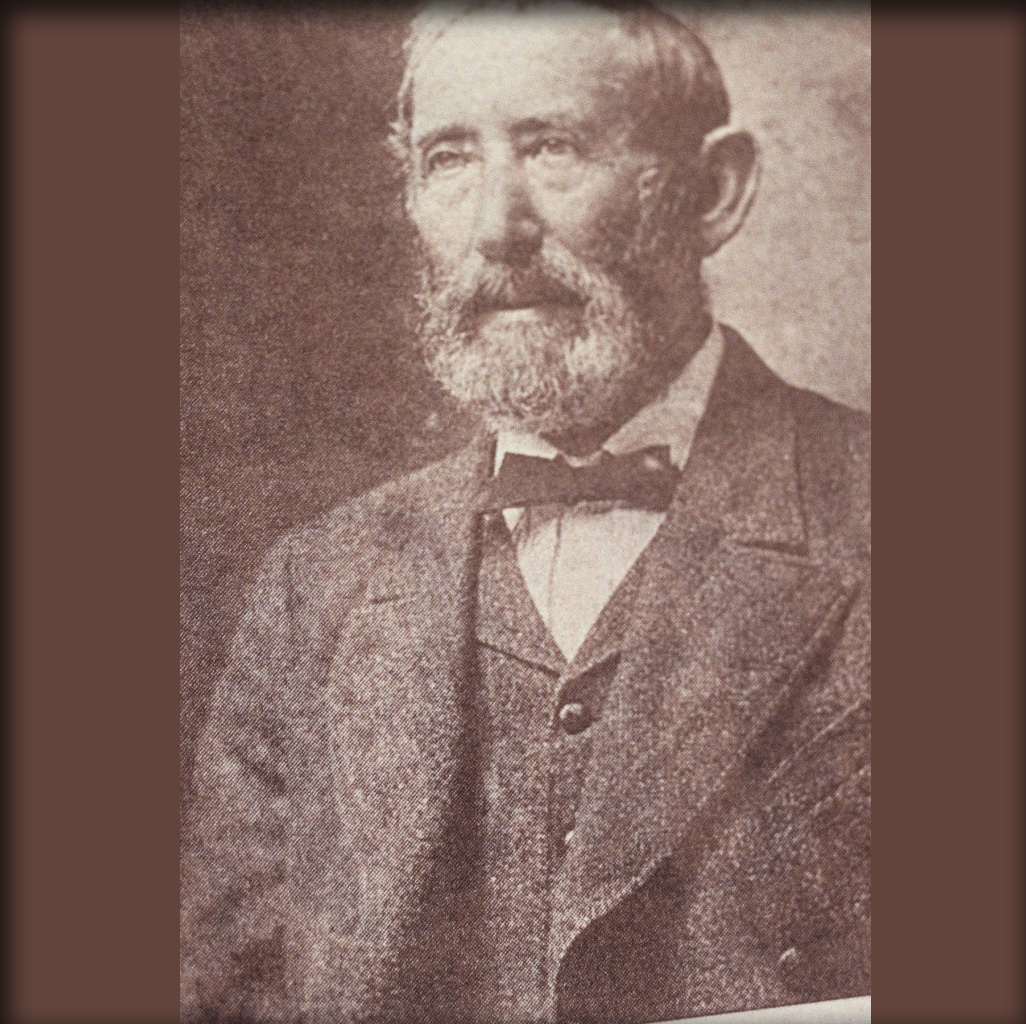 Westheimer, Michael Louis (1831-1905) – Entrepreneur – An emigrant from Germany, Westheimer came to Houston in 1859. He was quite a businessman. Westheimer owned a flourmill, a livery stable on the corner of Milan and Congress, was a hay merchant and laid the city’s first streetcar tracks. At auction he bought a 650 acre farm for $2.50 per acre west of town where Lamar High School and St. John’s School are today. Westheimer started a school on the property for his 16 children as well as his nieces and nephews who migrated here from Germany. The shell lane that led to the schoolhouse became known as “the road to Westheimer’s Place,” now known as Westheimer Road. Out of the livery business came Westheimer Transfer & Storage. The family once owned the Westheimer Undertaking & Embalming Company.
Westheimer, Michael Louis (1831-1905) – Entrepreneur – An emigrant from Germany, Westheimer came to Houston in 1859. He was quite a businessman. Westheimer owned a flourmill, a livery stable on the corner of Milan and Congress, was a hay merchant and laid the city’s first streetcar tracks. At auction he bought a 650 acre farm for $2.50 per acre west of town where Lamar High School and St. John’s School are today. Westheimer started a school on the property for his 16 children as well as his nieces and nephews who migrated here from Germany. The shell lane that led to the schoolhouse became known as “the road to Westheimer’s Place,” now known as Westheimer Road. Out of the livery business came Westheimer Transfer & Storage. The family once owned the Westheimer Undertaking & Embalming Company.


